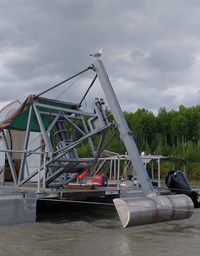Hydrokinetic Testing Gallops Along on Tanana River
ACEP researchers tested a Water Horse hydrokinetic energy system at the Tanana River Test Site for five days in July 2020.
The Water Horse prototype is based a concept developed by Renerge Inc. ACEP designed and built the prototype with funding from the Department of Energy Water Power Technologies Office.
The Water Horse, named for its use of the gallop phenomenon in fluid dynamics, is a unique approach to hydrokinetic energy. Unlike a bladed turbine spun by water, the water horse harnesses power from a bluff body, a horizontal half-cylinder at the bottom of a vertical beam. Vortices form as water flows past the bluff body. These vortices separate with a shedding frequency. The bluff body is supported by a spring mechanism that gives it a resonant frequency close to the vortex-shedding frequency. This combination can result in large amplitude oscillations, called "gallop."
This gallop phenomenon can be seen in ice-covered power lines or traffic signal arms bouncing in the wind. A catastrophic example was the Tacoma Narrows Bridge collapse in 1940.
While power-harnessing efficiency is low, galloping energy converters have the potential to be lower cost and less susceptible to debris than submerged turbines. In the current design, all moving parts are above the water, avoiding problems associated with submerged bearings and seals in traditional turbines. The bluff body is also more resilient to debris impacts than turbine blades.
The 2020 prototype field testing is intended to prove the concept at scale and to learn initial design and operations lessons. Using data collected and lessons learned from the 2020 prototype, ACEP will develop a second prototype for testing in 2021.
For more information on the Water Horse project, contact Ben Loeffler at bhloeffler@alaska.edu.




